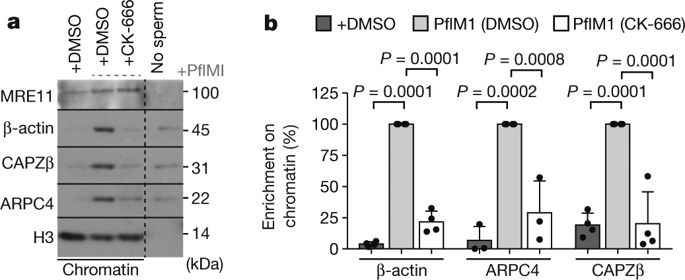Our official English website, www.x-mol.net, welcomes your
feedback! (Note: you will need to create a separate account there.)
Nuclear ARP2/3 drives DNA break clustering for homology-directed repair
Nature ( IF 50.5 ) Pub Date : 2018-06-20 , DOI: 10.1038/s41586-018-0237-5 Benjamin R. Schrank , Tomas Aparicio , Yinyin Li , Wakam Chang , Brian T. Chait , Gregg G. Gundersen , Max E. Gottesman , Jean Gautier
Nature ( IF 50.5 ) Pub Date : 2018-06-20 , DOI: 10.1038/s41586-018-0237-5 Benjamin R. Schrank , Tomas Aparicio , Yinyin Li , Wakam Chang , Brian T. Chait , Gregg G. Gundersen , Max E. Gottesman , Jean Gautier

|
DNA double-strand breaks repaired by non-homologous end joining display limited DNA end-processing and chromosomal mobility. By contrast, double-strand breaks undergoing homology-directed repair exhibit extensive processing and enhanced motion. The molecular basis of this movement is unknown. Here, using Xenopus laevis cell-free extracts and mammalian cells, we establish that nuclear actin, WASP, and the actin-nucleating ARP2/3 complex are recruited to damaged chromatin undergoing homology-directed repair. We demonstrate that nuclear actin polymerization is required for the migration of a subset of double-strand breaks into discrete sub-nuclear clusters. Actin-driven movements specifically affect double-strand breaks repaired by homology-directed repair in G2 cell cycle phase; inhibition of actin nucleation impairs DNA end-processing and homology-directed repair. By contrast, ARP2/3 is not enriched at double-strand breaks repaired by non-homologous end joining and does not regulate non-homologous end joining. Our findings establish that nuclear actin-based mobility shapes chromatin organization by generating repair domains that are essential for homology-directed repair in eukaryotic cells.Polymerization of actin in the cell nucleus, promoted by the ARP2/3 complex, drives the clustering of double-strand DNA breaks into nuclear compartments where they can undergo homology-directed repair.
中文翻译:

核 ARP2/3 驱动 DNA 断裂聚类以进行同源定向修复
通过非同源末端连接修复的 DNA 双链断裂显示出有限的 DNA 末端加工和染色体移动性。相比之下,经过同源定向修复的双链断裂表现出广泛的处理和增强的运动。这种运动的分子基础是未知的。在这里,使用非洲爪蟾无细胞提取物和哺乳动物细胞,我们确定核肌动蛋白、黄蜂和肌动蛋白成核 ARP2/3 复合物被招募到受损染色质,进行同源定向修复。我们证明,双链断裂子集迁移到离散的亚核簇中需要核肌动蛋白聚合。肌动蛋白驱动的运动特别影响 G2 细胞周期阶段同源定向修复修复的双链断裂;肌动蛋白成核的抑制会损害 DNA 末端加工和同源定向修复。相比之下,ARP2/3 在非同源末端连接修复的双链断裂处不富集,并且不调节非同源末端连接。我们的研究结果表明,基于核肌动蛋白的流动性通过生成对真核细胞中同源定向修复必不可少的修复域来塑造染色质组织。 ARP2/3 复合物促进细胞核中肌动蛋白的聚合,驱动双- DNA 链断裂成核区室,在那里它们可以进行同源定向修复。
更新日期:2018-06-20
中文翻译:

核 ARP2/3 驱动 DNA 断裂聚类以进行同源定向修复
通过非同源末端连接修复的 DNA 双链断裂显示出有限的 DNA 末端加工和染色体移动性。相比之下,经过同源定向修复的双链断裂表现出广泛的处理和增强的运动。这种运动的分子基础是未知的。在这里,使用非洲爪蟾无细胞提取物和哺乳动物细胞,我们确定核肌动蛋白、黄蜂和肌动蛋白成核 ARP2/3 复合物被招募到受损染色质,进行同源定向修复。我们证明,双链断裂子集迁移到离散的亚核簇中需要核肌动蛋白聚合。肌动蛋白驱动的运动特别影响 G2 细胞周期阶段同源定向修复修复的双链断裂;肌动蛋白成核的抑制会损害 DNA 末端加工和同源定向修复。相比之下,ARP2/3 在非同源末端连接修复的双链断裂处不富集,并且不调节非同源末端连接。我们的研究结果表明,基于核肌动蛋白的流动性通过生成对真核细胞中同源定向修复必不可少的修复域来塑造染色质组织。 ARP2/3 复合物促进细胞核中肌动蛋白的聚合,驱动双- DNA 链断裂成核区室,在那里它们可以进行同源定向修复。











































 京公网安备 11010802027423号
京公网安备 11010802027423号